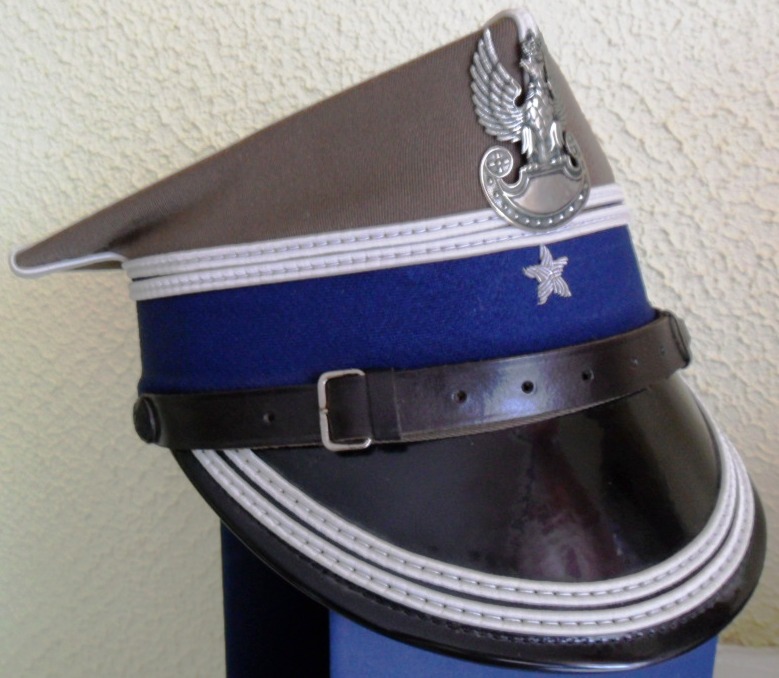Rogatywka on:
[Wikipedia]
[Google]
[Amazon]

 Rogatywka (; sometimes translated as ''
Rogatywka (; sometimes translated as ''
File:Rogatywka design 1919.PNG, Rogatywka design 1919
File:Jan_nowak_jezioranski-1936.jpg, Rogatywka design 1936
File:Rogatywka.JPG, Młodszy chorąży cap
File:Rogatywka-polowa.JPG, PRL era field cap
File:Rogatywka.jpg, A soldier from the
peaked cap
The peaked cap, peaked hat, service cap, barracks cover or combination cap is a form of headgear worn by the armed forces of many nations, as well as many uniformed civilian organisations such as law enforcement agencies and fire departments. It ...
'') is the Polish generic name for an asymmetrical
Asymmetry is the absence of, or a violation of, symmetry (the property of an object being invariant to a transformation, such as reflection). Symmetry is an important property of both physical and abstract systems and it may be displayed in pre ...
, peaked, four-pointed cap used by various Polish military formations throughout the ages. It is a distant relative of its 18th-century predecessor, konfederatka (because of use by members of the Bar Confederation), although similar caps have been used by light cavalry since the 14th century. It consists of a four-pointed top and a short peak, usually made of black or brown leather. Although rogatywka (derived from róg which means horn or corner) in English seems to mean the same as czapka
Czapka (, ; also spelt ''chapka'' or ''schapska'' ) is a Polish, Belarusian, and Russian generic word for a cap. However, it is perhaps best known to English speakers as a word for the 19th-century Polish cavalry headgear, consisting of a high ...
, the word 'czapka' in Polish designates not only rogatywka, but all caps (not hats).
Konfederatka
The konfederatka was based on the hats of the 18th-century Lithuanian TatarNational costume
A folk costume (also regional costume, national costume, traditional garment, or traditional regalia) expresses an identity through costume, which is usually associated with a geographic area or a period of time in history. It can also indicat ...
s, as the Grand Ducal Lithuanian Army's Vanguard regiments were heavily influenced by the Lithuanian Tatar dress, among other elements.
Usage
The rogatywka usually comes in two variants: the hardened and soft version. The hardened model, based on the rogatywka Mk. 1935, olive green with black peak, is used in full gala uniforms, while the rim colour marks unit type (for example, navy blue – typical, scarlet – military police, green – artillery, and so on). It was not worn during most of the People's Republic of Poland era but was reintroduced for ceremonial wear by the Honour Guard Company in 1983. The soft version was used beforeWorld War II
World War II or the Second World War, often abbreviated as WWII or WW2, was a world war that lasted from 1939 to 1945. It involved the vast majority of the world's countries—including all of the great powers—forming two opposing ...
and during the People's Republic of Poland period for garrison dress; it was withdrawn after 1990.
Polish soldiers decorate their caps not with the emblem of their corps, but with their service's version of the Polish military eagle
Military eagles ( pl, orły wojskowe) are military insignia used in the Polish Armed Forces, based on the White Eagle of the Polish coat of arms. They are used on elements of military uniforms such as hats and buttons, as well as on military banne ...
. The military eagle insignia is based on an early 19th-century design, comprising a modified White Eagle (from the Polish coat of arms) perched atop an 'amazon shield'.
Army branches are indicated by the following colored cap bands:
* navy blue – generals, mechanized troops, National Honour Guard
* brown – staff officers
* orange – units dedicated to honour history, armoured troops, scouts
* dark green – rocket forces, artillery, anti-aircraft units
* sky blue – army aviation (helicopters)
* red – intelligence
* maroon – transportation
* bronze – civil affairs
* purple – quartermaster corps, supply and logistics
* tan – ordnance
* black – engineering units, chemical corps, cartographic service, technical cadets
* silver – special forces
* cornflower – adjutant general corps, radio and communication corps
* white – infantry
* blue – paratroopers
* beige- recruit and retention
* cherry – medical service, medical cadets
* salmon – legal services
* mauve – public affairs
* goldenrod – military bands
* scarlet – military police
* gold – accounting and finance
* violet – chaplains
* yellow – headquarters of 1st Warsaw Mechanized Division, 1st Warsaw Armoured Division
Others
The rogatywka is used by Polish firefighters (hardened, all navy blue) andPolish State Railways
(''PKP S.A.''; en, Polish State Railways, Inc.) is the dominant Rail transport operations, railway operator in Poland.
The company was founded when the former state-owned enterprise was divided into several units based on the need for separati ...
staff (soft, navy blue or red).
Green rogatywkas with brown leather peak and scout Fleur-de-lis
The fleur-de-lis, also spelled fleur-de-lys (plural ''fleurs-de-lis'' or ''fleurs-de-lys''), is a lily (in French, and mean 'flower' and 'lily' respectively) that is used as a decorative design or symbol.
The fleur-de-lis has been used in the ...
symbol are traditionally worn by Polish boy scouts, while grey caps are sometimes used by girl guides.
Representative Honor Guard Regiment of the Polish Armed Forces
The Representative Honor Guard Regiment of the Polish Armed Forces ( pl, Pułk Reprezentacyjny Wojska Polskiego) is an Honor Guard unit of the Polish Armed Forces, of regimental size. It performs public duties for the armed forces and the Presiden ...
References
{{Hats Caps Polish military traditions Military uniforms